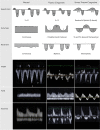The use of venous Doppler to predict adverse kidney events in a general ICU cohort
- PMID: 33076961
- PMCID: PMC7574322
- DOI: 10.1186/s13054-020-03330-6
The use of venous Doppler to predict adverse kidney events in a general ICU cohort
Abstract
Background: Changes in Doppler flow patterns of hepatic veins (HV), portal vein (PV) and intra-renal veins (RV) reflect right atrial pressure and venous congestion; the feasibility of obtaining these assessments and the clinical relevance of the findings is unknown in a general ICU population. This study compares the morphology of HV, PV and RV waveform abnormalities in prediction of major adverse kidney events at 30 days (MAKE30) in critically ill patients.
Study design and methods: We conducted a prospective observational study enrolling adult patients within 24 h of admission to the ICU. Patients underwent an ultrasound evaluation of the HV, PV and RV. We compared the rate of MAKE-30 events in patients with and without venous flow abnormalities in the hepatic, portal and intra-renal veins. The HV was considered abnormal if S to D wave reversal was present. The PV was considered abnormal if the portal pulsatility index (PPI) was greater than 30%. We also examined PPI as a continuous variable to assess whether small changes in portal vein flow was a clinically important marker of venous congestion.
Results: From January 2019 to June 2019, we enrolled 114 patients. HV abnormalities demonstrate an odds ratio of 4.0 (95% CI 1.4-11.2). PV as a dichotomous outcome is associated with an increased odds ratio of MAKE-30 but fails to reach statistical significance (OR 2.3 95% CI 0.87-5.96), but when examined as a continuous variable it demonstrates an odds ratio of 1.03 (95% CI 1.00-1.06). RV Doppler flow abnormalities are not associated with an increase in the rate of MAKE-30 INTERPRETATION: Obtaining hepatic, portal and renal venous Doppler assessments in critically ill ICU patients are feasible. Abnormalities in hepatic and portal venous Doppler are associated with an increase in MAKE-30. Further research is needed to determine if venous Doppler assessments can be useful measures in assessing right-sided venous congestion in critically ill patients.
Keywords: Ultrasound; Venous congestion; Venous return.
Conflict of interest statement
The authors declare that they have no competing interests.
Figures
Similar articles
-
Portal Vein Doppler Is a Sensitive Marker for Evaluating Venous Congestion in End-Stage Kidney Disease.Cardiorenal Med. 2024;14(1):375-384. doi: 10.1159/000539901. Epub 2024 Jun 19. Cardiorenal Med. 2024. PMID: 38897186
-
Multiorgan Congestion Assessment by Venous Excess Ultrasound Score in Acute Heart Failure.J Am Soc Echocardiogr. 2024 Oct;37(10):923-933. doi: 10.1016/j.echo.2024.05.011. Epub 2024 May 19. J Am Soc Echocardiogr. 2024. PMID: 38772454
-
Qualitative hepatic venous Doppler sonography versus portal flowmetry in predicting the severity of esophageal varices in hepatitis C cirrhosis.AJR Am J Roentgenol. 1997 Aug;169(2):511-5. doi: 10.2214/ajr.169.2.9242766. AJR Am J Roentgenol. 1997. PMID: 9242766
-
Doppler sonographic abnormalities suggestive of venous congestion in the right lobe graft of living donor liver transplant recipients.AJR Am J Roentgenol. 2007 Mar;188(3):W239-45. doi: 10.2214/AJR.05.1761. AJR Am J Roentgenol. 2007. PMID: 17312029 Review.
-
VExUS Nexus: Bedside Assessment of Venous Congestion.Adv Chronic Kidney Dis. 2021 May;28(3):252-261. doi: 10.1053/j.ackd.2021.03.004. Adv Chronic Kidney Dis. 2021. PMID: 34906310 Review.
Cited by
-
Hepatic vein Doppler in critically ill patients: a reflection of central venous pressure or right ventricular systolic function?BMC Anesthesiol. 2022 Oct 29;22(1):332. doi: 10.1186/s12871-022-01872-6. BMC Anesthesiol. 2022. PMID: 36309639 Free PMC article.
-
Assessing Fluid Intolerance with Doppler Ultrasonography: A Physiological Framework.Med Sci (Basel). 2022 Feb 9;10(1):12. doi: 10.3390/medsci10010012. Med Sci (Basel). 2022. PMID: 35225945 Free PMC article. Review.
-
Point-of-care ultrasound in diagnosis and management of congestive nephropathy.World J Crit Care Med. 2023 Mar 9;12(2):53-62. doi: 10.5492/wjccm.v12.i2.53. eCollection 2023 Mar 9. World J Crit Care Med. 2023. PMID: 37034023 Free PMC article. Review.
-
Definition and management of right ventricular injury in adult patients receiving extracorporeal membrane oxygenation for respiratory support using the Delphi method: a PRORVnet study. Expert position statements.Intensive Care Med. 2024 Sep;50(9):1411-1425. doi: 10.1007/s00134-024-07551-z. Epub 2024 Aug 5. Intensive Care Med. 2024. PMID: 39102027 Free PMC article.
-
Prospective Study of Ultrasound Markers of Organ Congestion in Critically Ill Patients With Acute Kidney Injury.Kidney Int Rep. 2023 Dec 29;9(3):694-702. doi: 10.1016/j.ekir.2023.12.018. eCollection 2024 Mar. Kidney Int Rep. 2023. PMID: 38481488 Free PMC article.
References
Publication types
MeSH terms
LinkOut - more resources
Full Text Sources
Medical



